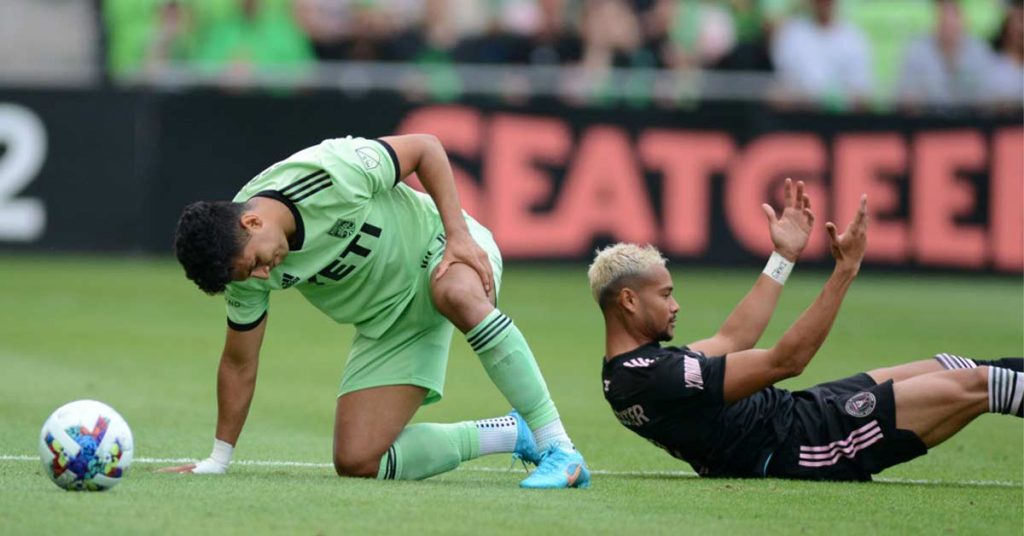
Dave Tenney is the High Performance Director for Austin FC and has spent almost two decades in elite performance roles in the MLS and NBA. Prior to joining Austin FC in their 2021 expansion year, he spent time in high-performance leadership roles with the Orlando Magic (2017–2020) and the Seattle Sounders (2009–2017).
Freelap USA: A decade ago with the Seattle Sounders, you helped shepherd in the integrated high-performance model that’s now common in the MLS. What are some of the most significant ways you’ve seen that model grow and evolve over the past 10 years?
David Tenney: It’s become more complex, which is true of the world we live in, isn’t it? Things become more complex as they grow, and staffs are getting bigger with interdisciplinary teams working together. Hopefully, we’re moving to a space where, as our leagues all evolve and our staffs grow, we have more of that interdisciplinary approach, where we understand where our skills and competencies overlap with another department’s skills and competencies, and we have people that are speaking the same language to answer questions collectively.
The world we live in is only becoming more complex and interconnected, and understanding that has been important in the development of these high-performance teams. And there’s a difference between complicated and complex. You want a certain level of simplicity, while also understanding complexity and not making things complicated.
You need a simplified and clear language that everyone understands, so each different discipline doesn’t use different phrases and words to discuss the same concept, says @DaveTenney. Share on XThis is why the implementation of a common language is so important. You need a simplified and clear language that everyone understands, so that each different discipline isn’t using different phrases and words to discuss the same concept.
Freelap USA: Keeping players on the field has always been a primary goal of that interdisciplinary performance team. From injury prediction models to injury mitigation methods, how has your approach to building more resilient players changed over time?
David Tenney: The number one most important part in all of this is collaboration with the actual coaching staff. If we are not collectively creating a weekly periodization for the team, then the performance staff is just trying to put Band-Aids on things.
In my current situation at Austin FC, I have myself and our assistant coach, Nolan Sheldon. The two of us collectively create the content for the training weeks, which the head coach (Josh Wolff) ultimately has veto power over. He decides how he’d like to stress certain tactical concepts. But when it comes to the actual loading and stresses that we put on the players, it has to be a collaboration between the coaching staff and the performance staff. You can model everything all you want in terms of who might be more at risk, and you can do all the prehab and strength work you want, but if you can really shape the loads and stresses you put on the players, then you have the best chance of being successful.

That goes back to the “same language” piece of performance staffs and coaching staffs seeing things the same way, and the coaching staff embracing days when you’re strength training or days when it’s your sprint/high-speed running day. You collectively know what you want to achieve tactically, physically, and cognitively and all the different components of player development. They’re all stressors, and the high-performance model is a collaborative model that should include the sport coaching staff within all the planning and periodization.
The high-performance model is a collaborative model that should include the sport coaching staff within all the planning and periodization, says @DaveTenney. Share on XFreelap USA: What is your process for performing a needs analysis when coming to a new team with different types of players and individualizing training for those players, while also adapting to a different coaching style or system?
David Tenney: In the specific case of Austin FC, by the nature of an expansion team, you ultimately end up signing more free agents and more older players because you need experience. The downside is that those older, experienced players have more wear and tear that you may have to be more careful about. So, out of the gate, we found that we needed a far more robust morning prehab/activation program than we normally would have in MLS.
As we’ve gone through the past 16 months, we now have a younger team. But I would reiterate that when you go into a new team, you need to have a needs analysis of the team and identify who can tolerate what kinds of stresses. You must compare that immediately with how the coach likes to train and what their vision is of a normal training week.
Where do they want to load the team and where do they want to unload the team? What day do they want to do 11 vs. 11? Are they okay pairing a training day with something that your performance staff wants to do in the gym? These obviously greatly impact the stresses that you will put on the athletes those days.
Then you have the player’s age and their previous injury history, and you must take those into account. Only then can you determine when and how to load the team over a week. In year two, it’s so much more streamlined than it was in year one because now we all understand how we like to work. We’ve all subtly shifted and evolved how we see the training week, taking into account the types of players that we have.
In particular, what are the heavy days when you really want to load certain physical qualities? Then, if you are able to load certain physical qualities, as a coaching staff and a performance staff, we all agree that there’s at least one day during the week when you need to unload as you get closer to the game. We have certainly been able to create our own high/low approach here with this coaching and performance staff.
Freelap USA: While it’s not uncommon for performance coaches to move to a comparable position in a different sport, for someone who played soccer professionally and has coached at a range of levels in the sport, your transition to High Performance Director with the Orlando Magic was a bit more unique. What were a few of the most unexpected differences you found with working in the NBA, and were there any lessons you picked up from coaching professional basketball players that you can bring back to your role with Austin FC?
David Tenney: I didn’t expect that the role with the Magic was going to be as different as it was, first and foremost. This was based on how many of these roles in the NBA end up being non-practitioner and more management-based. And certainly, my role was that.
Second, I clearly underestimated how well I know the sport of soccer, which comes from having played it until I was about 30. I thought that I would pick up the sport of basketball and the contextual awareness around what was going on in the games better than I ended up doing. Obviously, I think I would have gotten there if I’d continued spending time at it. However, I left after three seasons, thinking I never fully understood the intricacies of the game at the NBA level close to what I did in soccer.
I think I took my knowledge base around the sport of soccer for granted in a lot of ways, and that’s impactful. When you talk to a coaching staff or a GM or the athletes, if they all understand that you know the sport intimately, it makes a big difference. While I know the sport of soccer inside and out, I was just getting to know the sport of basketball. At the same time, I didn’t fall in love with basketball like I thought maybe I would. And it’s very hard to work the number of hours required of us per week without a love for the sport.
Having said that, the natures of the sports are totally different, because you go from a field-based sport with lots of sprinting and more soft tissue injuries to a very vertical sport where you have lots of degenerative joint issues and tendon issues. From that standpoint, it was a whole new type of injury management than you really see in soccer, so that was obviously interesting as well.
Freelap USA: Throughout your career, you’ve earned a reputation for being an early adopter of new technologies and training methods and for having a clear practical sense of how to apply those toward a well-defined goal. Over the last handful of years, what are a couple of the new tools, technologies, or innovations that you’ve begun to use effectively in your programming?
David Tenney: Most top leagues in the world now utilize optical tracking systems, and that has provided teams with lots of data. Ultimately, what we really want to do is be able to see how our team is performing within their competition, right? So, optical tracking gives us a sense of how they’re performing and some of the why as well: it’s the interaction with the opponent, how shifts in tactics affect physical outputs, how different players are physically stressed in different ways.
It’s the interaction of your team with the opponent that really lets you understand why certain players had to do a certain amount of physical work or maybe weren’t able to do enough, says @DaveTenney. Share on XTeams around the U.S. are using GPS and heart rate and effectively tracking what’s going on in practices—and even wearing GPS in games, which does have value. However, I think it’s the interaction of your team with the opponent that really lets you understand why certain players had to do a certain amount of physical work or maybe were asked to but weren’t capable of doing enough.
How certain games fluctuate in terms of tempo and intensity, what that does to physical outputs, and how it potentially creates fatigue: This information helps you build worst-case scenarios for your athletes or training exercises to stress certain positions in certain ways. This also enables you and the coaching staff to determine how certain positions might be overloaded by certain games, and why.
So, I would say from that standpoint, in-game measurement and monitoring has changed. With Second Spectrum data, you actually have real-time data (or a short lag time) of what’s going on in the game from a physical standpoint, and that’s been interesting this year in MLS.
There are also tools like the 1080 Sprint that we have begun to use. The tech provides the ability to create some really good sprint profiling, and these are becoming more commonplace globally. Rather than purely in-weight-room type work, we’re now doing things like 10-meter resisted sprint work with the 1080 during the team lift right in the space between the soccer field and the weight room. This has become a new training and assessment tool.
Lead photo by John Rivera/Icon Sportswire.
Since you’re here…
…we have a small favor to ask. More people are reading SimpliFaster than ever, and each week we bring you compelling content from coaches, sport scientists, and physiotherapists who are devoted to building better athletes. Please take a moment to share the articles on social media, engage the authors with questions and comments below, and link to articles when appropriate if you have a blog or participate on forums of related topics. — SF

